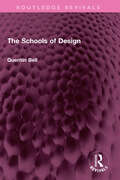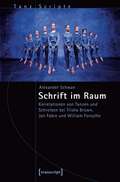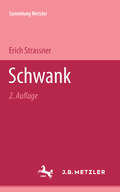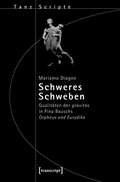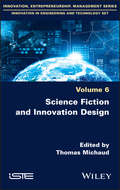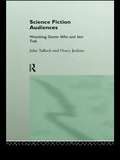- Table View
- List View
The Schools of Design (Routledge Revivals)
by Quentin BellFirst published in 1963, The Schools of Design is a history of English Art Education. The story of the genesis of English art schools is one of the fierce conflicts in which private feuds mingle with questions of principle. It is a story of administrative chaos and open scandal in which some long-forgotten figures are involved; others – such as Haydon, Gladstone, Alfred Stevens, Dyce, Stafford Northcote, Etty and Henry Role – appear in a new role. In itself this forms an entertaining study full of incident and drama. Many of the problems that presented themselves in the 1840’s are still with us today and no one who is interested in the place of art in our society can afford to neglect the lessons of the Schools of Design. This book will be of interest to students of art and history.
The Schools of Design (Routledge Revivals)
by Quentin BellFirst published in 1963, The Schools of Design is a history of English Art Education. The story of the genesis of English art schools is one of the fierce conflicts in which private feuds mingle with questions of principle. It is a story of administrative chaos and open scandal in which some long-forgotten figures are involved; others – such as Haydon, Gladstone, Alfred Stevens, Dyce, Stafford Northcote, Etty and Henry Role – appear in a new role. In itself this forms an entertaining study full of incident and drama. Many of the problems that presented themselves in the 1840’s are still with us today and no one who is interested in the place of art in our society can afford to neglect the lessons of the Schools of Design. This book will be of interest to students of art and history.
Schreiben in der Kunst: Amerikanische Künstlertexte der 1960er Jahre (Image #119)
by Dorothee WagnerKaum ein Beitrag zur Minimal und Conceptual Art kommt ohne die Referenz zu den Texten ihrer Künstlerinnen und Künstler aus. Welchen Einfluss hat jedoch die Position des Verfassers oder der Verfasserin auf das Schreiben und die Lektüre? Ausgehend von Fragestellungen aus der Kunst- und Literaturtheorie zeigt Dorothee Wagner, dass Künstlerinnen und Künstler wie Ad Reinhardt, Robert Morris, Donald Judd, Sol LeWitt, Joseph Kosuth, Dan Flavin, Dan Graham, Yvonne Rainer und Robert Smithson sich auf jeweils unterschiedliche Weise dem Schreiben und Veröffentlichen bedienten: Die Re-Lektüre dieser Texte erlaubt dabei einen Zugang zum Schreiben als künstlerische Strategie wie auch zu Künstlerschriften als Quelle und Material im Allgemeinen.
Schrift im Raum: Korrelationen von Tanzen und Schreiben bei Trisha Brown, Jan Fabre und William Forsythe (TanzScripte #47)
by Alexander H. SchwanAlexander H. Schwan nimmt den bekannten Vergleich von Tanzen und Schreiben neu in den Blick und entwickelt erstmals eine umfassende Poetik der Bewegung als körperliche Schrift: écriture corporelle. Im intensiven Dialog mit Schrift- und Bildtheorien analysiert er herausragende Arbeiten postmoderner und zeitgenössischer Choreographie, die Tanzbewegungen als ephemere Einschreibung im Raum organisieren. Er zeigt exemplarisch auf, wie diese Körperfigurationen als Veränderung eines imaginären Schriftbildes betrachtet werden können. So eröffnet die Studie wichtige theoretische Perspektiven für die Tanzwissenschaft und verändert die Wahrnehmung von Bewegung: Tanz wird sichtbar als flüchtiges Schreiben und unlesbare Schrift im Raum.
Schulbauten - Debatten, Darstellungen und Aneignungspraktiken von 1968 bis heute (Architekturen #70)
by Eva ZeppIn der Debatte um die Demokratisierung von Bildungseinrichtungen änderte sich der Blick auf Schulgebäude und ihre Nutzung seit den 1960er Jahren grundlegend und es rückte eine weitere Funktion in den Vordergrund: die Rolle von Schularchitektur als Imageträger. Eva Zepp rekonstruiert den Diskurs um ein höheres Maß an Mitbestimmung bei der Planung von Schulbauten und deren mediale Repräsentationen. Anhand von Dokumenten aus Forschungsarchiven, Berichten und Bildstrecken in Architekturzeitschriften sowie zwei prominent diskutierten Schulbauten analysiert sie die Rollen und Praktiken von Nutzer*innen und zeigt: Wo verschiedene Interessen aufeinandertreffen, braucht es eine partizipative Planungspraxis, die Raum für Eigensinn und Dissens öffnet.
Schulen weiterbauen: Strategische Entwicklung von Schulgebäudebeständen (Architekturen #46)
by Maja LorbekUnterrichtspraktiken und soziale Beziehungen in den Schulen werden nicht zuletzt durch die vorherrschenden Gebäudestrukturen geprägt. Das stabile sozio-technische Regime der Schule, das auf dem Prinzip des Klassenzimmers und dem System Lehrer-Klasse beruht, kann nur langfristig und mithilfe einer Gesamtstrategie verändert werden. Dieser Aspekt ist besonders relevant, wenn es um die Modernisierung historischer Schulgebäude geht. Doch wie kann eine Modernisierung geplant werden, die Fehlentwicklungen vermeidet und langfristig tragfähige Strategien ermöglicht? Maja Lorbek stellt die Szenario-Entwicklung als Planungsinstrument zur Schulmodernisierung vor. Anhand einiger Szenarien - wie etwa dem des »Kontrollierten Schulmarkts«, welches ein Schulsystem ohne staatliches Bildungsmonopol beschreibt, oder dem der »Differenzierten Schule« als Darstellung der Folgen bisheriger Praxis - wird die Tragfähigkeit des Instruments diskutiert.
Schulische Kabinettprojektion: Räumliches Zeichnen im Raster (essentials)
by Berthold HeinrichBerthold Heinrich stellt die mathematischen und zeichnerischen Grundlagen für die Darstellung von Objekten im Raum auf kariertem Papier vor. Dabei präsentiert er auch die Nutzung von Software. In der Schule wird oft kariertes Papier als Raster zur Darstellung von Flächen und Körpern genutzt. Allerdings werden, selbst in einigen Druckwerken, z.B. die entstehenden Ellipsen und Winkelbögen ungenau gezeichnet oder eine Kugelkontur falsch als Kreis dargestellt. Im vorliegenden Essential werden die korrekten Verfahren sowohl theoretisch als auch an konkreten Beispielen vorgestellt und können meist direkt umgesetzt werden. Einige aufwändigere Abläufe stellt der Autor anschaulich an Beispielen dar.
Schwarzenegger: Uses of the Foreign Star
by Gábor GergelyThis book analyses the uses of Arnold Schwarzenegger as a foreign star in Hollywood through a film philosophical, de-westernizing and sonic critical framework. It offers very close readings of the film texts, of the roles Schwarzenegger performs, and the rhetorical strategies he adopts outside his film performances to show that in spite of attempts to occupy the position of an emblematic member of the U.S. national body Schwarzenegger remains irrevocably outside as an accented migrant body continuously accumulating markers of belonging that by their very necessity attest to their insufficiency. The book’s central project is to trace back, from the uses to which a migrant star such as Schwarzenegger is put on the screen, the construction of a sense or idea of a U.S. national community through the cinema. Given that the appeal to the American myth of an immigrant nation that promises to erase difference is fundamental to the Schwarzenegger star persona, the central aim of this book is to explore the uses of his stardom as an embodiment of the promise of America and its contradictions and exclusions.
Schweres Schweben: Qualitäten der gravitas in Pina Bauschs Orpheus und Eurydike (TanzScripte #53)
by Mariama DiagneDie Gleichzeitigkeit von schwer und leicht im Denken und Bewegen wird seit der Antike gravitas genannt. In der Barockzeit entstand daraus eine Grundhaltung: Mit dem Luftschritt pas grave wird der Körper kurz vor dem Bodenkontakt angehoben. Später entwickelte sich das Ideal der schwerelosen Ballerina, von dem sich Tanzschaffende seit der Moderne wiederum deutlich distanzieren. In Pina Bauschs Tanzoper Orpheus und Eurydike scheinen die Dichotomien schwer/männlich vs. leicht/weiblich umgewertet: Mühevoll trägt Orpheus seine schwere Schattenfrau Eurydike durch den Hades. Mit dem Schweren Schweben entwickelt die Studie eine Denkfigur, die das Schweben in der europäisch geprägten Kulturgeschichte anhand des Tanztheaters neu kontextualisiert.
Science: Vintage Minis (Vintage Minis)
by Ian McEwan‘This is a history of intellectual courage, hard work, occasional inspiration and every conceivable form of human failing. It is also an extended invitation to wonder, to pleasure’How far have we come in our understanding of the world around us? In this eye-opening collection, Ian McEwan looks back at the history of scientific discovery from Darwin to Dawkins as well as exploring, with brilliant originality, what a future with AI and climate change could hold for us. Selected from Solar, Enduring Love, Machines Like MeVINTAGE MINIS: GREAT MINDS. BIG IDEAS. LITTLE BOOKS.A series of short books by the world’s greatest writers on the experiences that make us humanAlso in the Vintage Minis 'Great Ideas' series:Religion by Karen ArmstrongArt by Simon Schama
The Science and Art of Acting for the Camera: A Practical Approach to Film, Television, and Commercial Acting
by John Howard SwainThe Science and Art of Acting for the Camera provides a precise yet practical approach to help unlock the mysteries of acting for film and television. Written by veteran actor, producer, and director John Howard Swain, the book offers a clear-cut, no-nonsense technique that equips aspiring or working actors with the necessary skills to succeed on camera. The technique teaches you how to build multi-dimensional characters; construct truthful and exciting relationships; ignite stimulating emotions; craft a series of discoveries guaranteed to energize your work; and much, much more. The book also provides instruction for actors working in commercials—from slating, to the dreaded "tell us about yourself" interview, to nailing "the tag" and embracing the cliché—and supplies sample commercial copy for students to practice.
The Science and Art of Acting for the Camera: A Practical Approach to Film, Television, and Commercial Acting
by John Howard SwainThe Science and Art of Acting for the Camera provides a precise yet practical approach to help unlock the mysteries of acting for film and television. Written by veteran actor, producer, and director John Howard Swain, the book offers a clear-cut, no-nonsense technique that equips aspiring or working actors with the necessary skills to succeed on camera. The technique teaches you how to build multi-dimensional characters; construct truthful and exciting relationships; ignite stimulating emotions; craft a series of discoveries guaranteed to energize your work; and much, much more. The book also provides instruction for actors working in commercials—from slating, to the dreaded "tell us about yourself" interview, to nailing "the tag" and embracing the cliché—and supplies sample commercial copy for students to practice.
Science and Art Symposium 2000: 3rd International Conference on Flow Interaction of Science and Art with Exhibition/Lectures on Interaction of Science & Art, 28.2 — 3.3 2000 at the ETH Zurich
by A. Gyr Petros D. Koumoutsakos U. BurrSome words about SCART 2000. SCART stands for science and art. SCART meetings are organized in a loose time sequence by an international group of scientists, most of them fluid-dynamicists. The first meeting was held in Hong-Kong, the second one in Berlin, and the third, and latest, one in Zurich. SCART meetings include a scientific conference and a number of art events. The intention is to restart a dialogue between scientists and artists which was so productive in the past. To achieve this goal several lectures given by scientists at the conference are intended for a broader public. In the proceedings they are denoted as SCART lectures. The artists in tum address the main theme of the conference with their contributions. The lectures at SCART 2000 covered the entire field of fluiddynamics, from laminar flows in biological systems to astrophysical events, such as the explosion of a neutron star. The main exhibition by Dutch and Swiss artists showed video and related art under the title 'Walking on Air'. Experimental music was performed in two concerts.
Science and Digital Technology for Cultural Heritage - Interdisciplinary Approach to Diagnosis, Vulnerability, Risk Assessment and Graphic Information Models: Proceedings of the 4th International Congress Science and Technology for the Conservation of Cultural Heritage (TechnoHeritage 2019), March 26-30, 2019, Sevilla, Spain
by Pilar Ortiz Calderón Francisco Pinto Puerto Philip Verhagen Andrés J. PrietoThe scientific and technological advances that influence the protection of cultural heritage are developing at an ever-increasing pace. Systems to explore, research and analyse their materiality, to control the different scopes, or to represent and model them have reached an unprecedented dimension in recent decades. The Network of Science and Technology for the Conservation of Cultural Heritage aims to promote collaboration between the agents of these systems, in order to facilitate the sharing of experiences and to foster technology transfer, with the common goal of contributing to the conservation of Cultural Heritage. In the context of the TechnoHeritage Network, the fourth edition of the International Congress on Science and Technology for the Conservation of Cultural Heritage was held March 26-30, 2019, in Seville, Spain. This Congress was an international meeting of researchers and specialists from multiple areas, whose line of work is the knowledge and conservation of Cultural Heritage. Among all the topics discussed, the role and impact of digital technologies for the knowledge, maintenance, management and dissemination of cultural heritage should be highlighted. Digital media modify the way of understanding this heritage, of perceiving it and transmitting it, and offer a new horizon of strategies to make decision-making more sustainable over time.
Science and Drama: Contemporary and Creative Approaches to Teaching and Learning
by Peta J White Jo Raphael Kitty Van CuylenburgThis edited volume presents interdisciplinary and transdisciplinary approaches to drama and science in education. Drawing on a solid basis of research, it offers theoretical backgrounds, showcases rich examples, and provides evidence of improved student learning and engagement. The chapters explore various connections between drama and science, including: students’ ability to engage with science through drama; dramatising STEM; mutuality and inter-relativity in drama and science; dramatic play-based outdoor activities; and creating embodied, aesthetic and affective learning experiences. The book illustrates how drama education draws upon contemporary issues and their complexity, intertwining with science education in promoting scientific literacy, creativity, and empathetic understandings needed to interpret and respond to the many challenges of our times. Findings throughout the book demonstrate how lessons learned from drama and science education can remain discrete yet when brought together, contribute to deeper, more engaged and transformative student learning.
Science, Entertainment and Television Documentary
by Vincent CampbellThe shift from traditional documentary to “factual entertainment” television has been the subject of much debate and criticism, particularly with regard to the representation of science. New types of factual programming that combine documentary techniques with those of entertainment formats (such as drama, game-shows and reality TV) have come in for strident criticism. Often featuring spectacular visual effects produced by Computer Generated Imagery these programmes blur the boundaries between mainstream science and popular beliefs. Through close analysis of programmes across a range of sciences, this book explores these issues to see if criticisms of such hybrid programmes as representing the “rotting carcass of science TV” really are valid. Campbell considers if in fact; when considered in relation to the principles, practices and communication strategies of different sciences; these shows can be seen to offer more complex and rich representations that construct sciences as objects of wonder, awe and the sublime.
Science Fiction: A Guide for the Perplexed (Guides for the Perplexed)
by Sherryl VintFrom its beginnings in the works of H.G. Wells and Jules Verne to the virtual worlds of William Gibson's Neuromancer and The Matrix, Science Fiction: A Guide to the Perplexed helps students navigate the often perplexing worlds of a perennially popular genre. Drawing on literature as well as example from film and television, the book explores the different answers that criticism has offered to the vexed question, 'what is science fiction?' Each chapter of the book includes case studies of key texts, annotated guides to further reading and suggestions for class discussion to help students master the full range of contemporary critical approaches to the field, including the scientific, technological and political contexts in which the genre has flourished. Ranging from an understanding of the genre through the stereotypes of 1930s pulps through more recent claims that we are living in a science fictional moment, this volume will provide a comprehensive overview of this diverse and fascinating genre.
Science Fiction: Science Fiction And The Question Of The Animal (Guides for the Perplexed #108)
by Sherryl VintFrom its beginnings in the works of H.G. Wells and Jules Verne to the virtual worlds of William Gibson's Neuromancer and The Matrix, Science Fiction: A Guide to the Perplexed helps students navigate the often perplexing worlds of a perennially popular genre. Drawing on literature as well as example from film and television, the book explores the different answers that criticism has offered to the vexed question, 'what is science fiction?' Each chapter of the book includes case studies of key texts, annotated guides to further reading and suggestions for class discussion to help students master the full range of contemporary critical approaches to the field, including the scientific, technological and political contexts in which the genre has flourished. Ranging from an understanding of the genre through the stereotypes of 1930s pulps through more recent claims that we are living in a science fictional moment, this volume will provide a comprehensive overview of this diverse and fascinating genre.
Science Fiction and Digital Technologies in Argentine and Brazilian Culture
by E. KingFictional narratives produced in Latin America often borrow tropes from contemporary science fiction to examine the shifts in the nature of power in neoliberal society. King examines how this leads towards a market-governed control society and also explores new models of agency beyond that of the individual.
Science Fiction and Innovation Design
by Thomas MichaudScience fiction is often presented as a source of utopia, or even of prophecies, used in capitalism to promote social, political and technoscientific innovations. Science Fiction and Innovation Design assesses the validity of this approach by exploring the impact this imaginary world has on the creativity of engineers and researchers. Companies seek to anticipate and predict the future through approaches such as design fiction: mobilizing representations of science fiction to create prototypes and develop scenarios relevant to organizational strategy. The conquest of Mars or the weapons of the future are examples developed by authors to demonstrate how design innovation involves continuous dialogue between multiple players, from the scientist to the manager, through to the designers and the science fiction writers.
Science Fiction and Innovation Design
by Thomas MichaudScience fiction is often presented as a source of utopia, or even of prophecies, used in capitalism to promote social, political and technoscientific innovations. Science Fiction and Innovation Design assesses the validity of this approach by exploring the impact this imaginary world has on the creativity of engineers and researchers. Companies seek to anticipate and predict the future through approaches such as design fiction: mobilizing representations of science fiction to create prototypes and develop scenarios relevant to organizational strategy. The conquest of Mars or the weapons of the future are examples developed by authors to demonstrate how design innovation involves continuous dialogue between multiple players, from the scientist to the manager, through to the designers and the science fiction writers.
Science Fiction Audiences: Watching Star Trek and Doctor Who (Popular Fictions Series)
by Henry Jenkins John TullochScience Fiction Audiences examines the astounding popularity of two television "institutions" - the series Doctor Who and ^Star Trek. Both of these programmes have survived cancellation and acquired an following that continues to grow. The book is based on over ten years of research including interviews with fans and followers of the series. In that period, though the fans may have changed, and ways of studying them as "audiences" may have also changed, the programmes have endured intact, with Star Trek for example now in its fourth television incarnation. John Tulloch and Henry Jenkins dive into the rich fan culture surrounding the two series, exploring issues such as queer identity, fan meanings, teenage love of science fiction, and genre expectations. They encompass the perspectives of a vast population of fans and followers throughout Britain, Australia and the US, who will continue the debates contained in the book, along with those who will examine the historically changing range of audience theory it presents. and continue to attract a huge community of fans and followers. Doctor Who has appeared in nine different guises and Star Trek is now approaching its fourth television incarnation.Science Fiction Audiences examines the continuing popularity of two television 'institutions' of our time through their fans and followers. Through dialogue with fans and followers of Star Trek and Dr Who in the US, Britain and Australia, John Tulloch and Henry Jenkins ask what it is about the two series that elicits such strong and active responses from their audiences. Is it their particular intervention into the SF genre? Their expression of peculiarly 'American' and 'British' national cultures. Their ideologies and visions of the future, or their conceptions of science and technology? Science Fiction Audiences responds to a rich fan culture which encompasses debates about fan aesthetics, teenage attitudes to science fiction, queers and Star Trek, and ideology and pleasure in Doctor Who. It is a book written both for fans of the two series, who will be able to continue their debates in its pages, and for students of media and cultural studies, offering a historical overview of audience theory in a fascinating synthesis of text, context and audience study.
Science Fiction Audiences: Watching Star Trek and Doctor Who (Popular Fictions Series)
by Henry Jenkins John TullochScience Fiction Audiences examines the astounding popularity of two television "institutions" - the series Doctor Who and ^Star Trek. Both of these programmes have survived cancellation and acquired an following that continues to grow. The book is based on over ten years of research including interviews with fans and followers of the series. In that period, though the fans may have changed, and ways of studying them as "audiences" may have also changed, the programmes have endured intact, with Star Trek for example now in its fourth television incarnation. John Tulloch and Henry Jenkins dive into the rich fan culture surrounding the two series, exploring issues such as queer identity, fan meanings, teenage love of science fiction, and genre expectations. They encompass the perspectives of a vast population of fans and followers throughout Britain, Australia and the US, who will continue the debates contained in the book, along with those who will examine the historically changing range of audience theory it presents. and continue to attract a huge community of fans and followers. Doctor Who has appeared in nine different guises and Star Trek is now approaching its fourth television incarnation.Science Fiction Audiences examines the continuing popularity of two television 'institutions' of our time through their fans and followers. Through dialogue with fans and followers of Star Trek and Dr Who in the US, Britain and Australia, John Tulloch and Henry Jenkins ask what it is about the two series that elicits such strong and active responses from their audiences. Is it their particular intervention into the SF genre? Their expression of peculiarly 'American' and 'British' national cultures. Their ideologies and visions of the future, or their conceptions of science and technology? Science Fiction Audiences responds to a rich fan culture which encompasses debates about fan aesthetics, teenage attitudes to science fiction, queers and Star Trek, and ideology and pleasure in Doctor Who. It is a book written both for fans of the two series, who will be able to continue their debates in its pages, and for students of media and cultural studies, offering a historical overview of audience theory in a fascinating synthesis of text, context and audience study.
Science Fiction Cinema and 1950s Britain: Recontextualizing Cultural Anxiety
by Matthew JonesFor the last sixty years discussion of 1950s science fiction cinema has been dominated by claims that the genre reflected US paranoia about Soviet brainwashing and the nuclear bomb. However, classic films, such as Invasion of the Body Snatchers (1956) and It Came from Outer Space (1953), and less familiar productions, such as It! The Terror from Beyond Space (1958), were regularly exported to countries across the world. The histories of their encounters with foreign audiences have not yet been told. Science Fiction Cinema and 1950s Britain begins this task by recounting the story of 1950s British cinema-goers and the aliens and monsters they watched on the silver screen. Drawing on extensive archival research, Matthew Jones makes an exciting and important intervention by locating American science fiction films alongside their domestic counterparts in their British contexts of release and reception. He offers a radical reassessment of the genre, demonstrating for the first time that in Britain, which was a significant market for and producer of science fiction, these films gave voice to different fears than they did in America. While Americans experienced an economic boom, low immigration and the conferring of statehood on Alaska and Hawaii, Britons worried about economic uncertainty, mass immigration and the dissolution of the Empire. Science Fiction Cinema and 1950s Britain uses these and other differences between the British and American experiences of the 1950s to tell a new history of the decade's science fiction cinema, exploring for the first time the ways in which the genre came to mean something unique to Britons.
